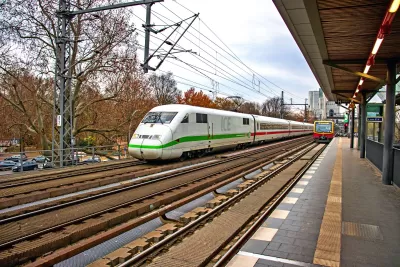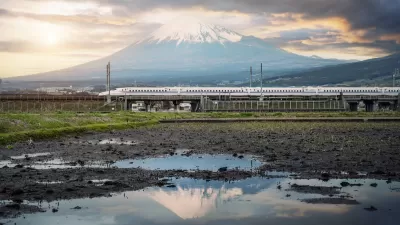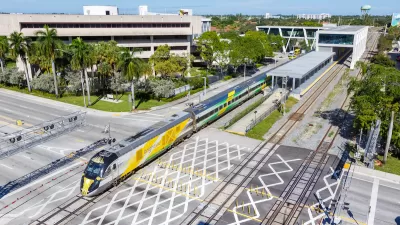If completed, the North Atlantic Rail project could transform New England's transportation landscape.

A proposed high-speed rail megaproject would connect New York and Boston via Hartford and Providence, promising a faster commute for the region's millions of workers. Anthony Flint reports on the project for Bloomberg CityLab.
The private backers of the North Atlantic Rail Project hope to attract President "Amtrak Joe" Biden's attention and federal investment, claiming that their project "checks all the boxes for a multi-benefit recovery strategy." NAR promises to cut travel time between New York and Boston down to 100 minutes, two hours shorter than Amtrak's current service. The project's supporters say it would benefit not only residents of Boston and New York but also those in the "left-behind, post-industrial legacy cities" between the two, which could see an influx of new investment and development if they become accessible by high-speed rail.
In the final phase, the NAR network would add more stops in smaller cities, making it easier for people to travel throughout the region and potentially easing housing affordability issues. Hartford mayor Luke Bronin, co-chair of the North Atlantic Rail initiative, said the new connections "would unlock economic opportunity and spur growth for dozens of mid-sized cities throughout New England, connecting the entire region in one integrated market for ideas, labor and innovation."
One major hiccup could be the project's $105-billion price tag, with the massive cost due in part to the engineering challenges faced in building and tunneling in densely developed areas and underwater. When compared to other projects around the world, however, NAR would be a small step in bringing the United States closer to having a world-class transportation system.
FULL STORY: Is This High-Speed Train the First Megaproject of the Biden Era?

Study: Maui’s Plan to Convert Vacation Rentals to Long-Term Housing Could Cause Nearly $1 Billion Economic Loss
The plan would reduce visitor accommodation by 25,% resulting in 1,900 jobs lost.

North Texas Transit Leaders Tout Benefits of TOD for Growing Region
At a summit focused on transit-oriented development, policymakers discussed how North Texas’ expanded light rail system can serve as a tool for economic growth.

Using Old Oil and Gas Wells for Green Energy Storage
Penn State researchers have found that repurposing abandoned oil and gas wells for geothermal-assisted compressed-air energy storage can boost efficiency, reduce environmental risks, and support clean energy and job transitions.

Private Donations Propel Early Restoration of Palisades Playground
Los Angeles has secured over $1.3 million in private funding to restore the Pacific Palisades playground months ahead of schedule, creating a modern, accessible space that supports community healing after recent wildfires.

From Blight to Benefit: Early Results From California’s Equitable Cleanup Program
The Equitable Community Revitalization Grant (ECRG) program is reshaping brownfield redevelopment by prioritizing projects in low-income and environmental justice communities, emphasizing equity, transparency, and community benefits.

Planting Relief: Tackling Las Vegas Heat One Tree at a Time
Nevada Plants, a Las Vegas-based nonprofit, is combating the city’s extreme urban heat by giving away trees to residents in underserved neighborhoods, promoting shade, sustainability, and community health.
Urban Design for Planners 1: Software Tools
This six-course series explores essential urban design concepts using open source software and equips planners with the tools they need to participate fully in the urban design process.
Planning for Universal Design
Learn the tools for implementing Universal Design in planning regulations.
Ascent Environmental
Borough of Carlisle
Institute for Housing and Urban Development Studies (IHS)
City of Grandview
Harvard GSD Executive Education
Toledo-Lucas County Plan Commissions
Salt Lake City
NYU Wagner Graduate School of Public Service





























